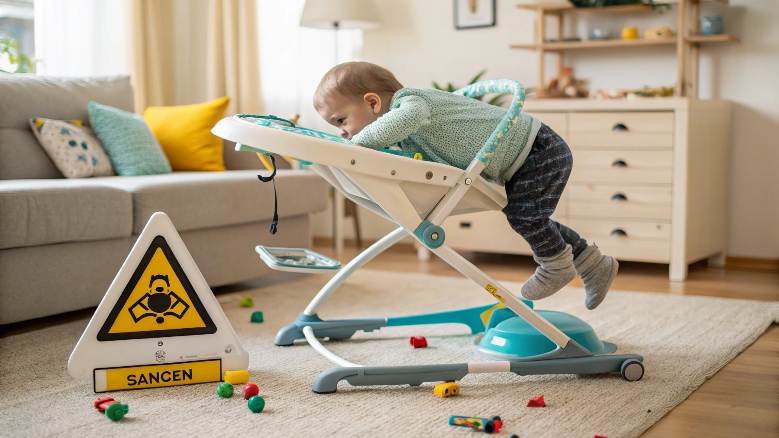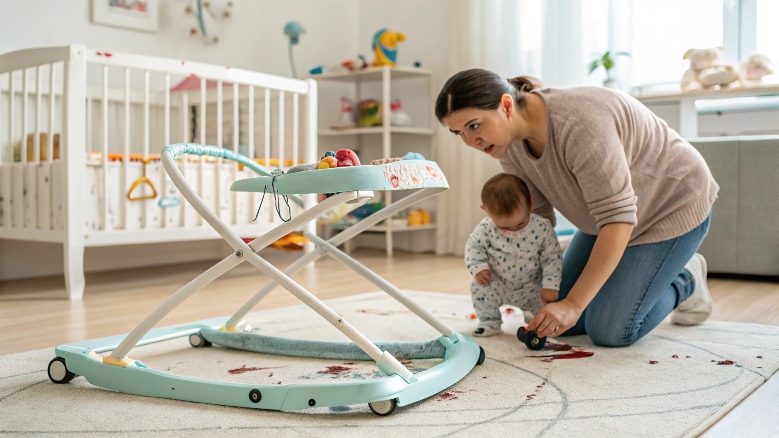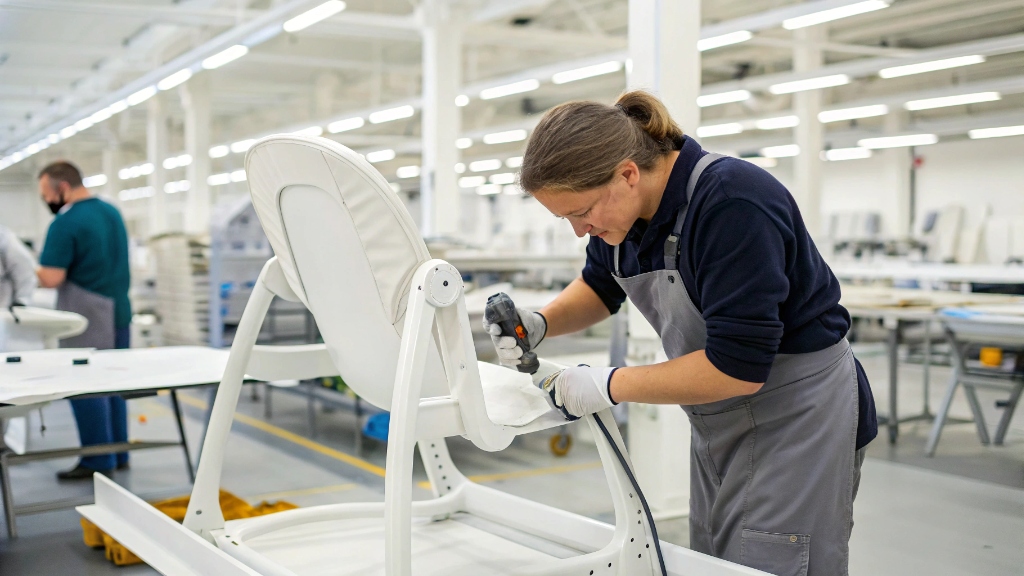Parents often believe baby walkers help their little ones learn to walk. But this common belief hides a serious truth. I want to tell you about the hidden dangers.
Yes, baby walkers are dangerous. They give babies unnatural speed and mobility, leading to preventable injuries like falls down stairs, burns, and poisonings, while actually delaying proper motor skill development and independent walking.

I have heard countless stories from parents, and seen the research myself. The risks associated with these devices are very real and often surprising. Understanding these specific dangers is the first step toward making safer choices for your child’s development.
What Are the Dangers of Baby Walkers?
Parents often see walkers as a fun way to help babies move. But they can cause serious harm. I want to show you the real problems these devices create.
Baby walkers pose dangers like falls down stairs, access to hazards such as hot liquids or chemicals, and delayed motor skill development because they do not teach natural balance and can reduce floor time.

I have seen firsthand how quickly a baby in a walker can get into trouble. One moment they are across the room, the next they are near a hot stove or a staircase. The speed a walker allows a baby to achieve is much faster than their natural crawling or cruising pace. This means a parent has less time to react to a dangerous situation. Babies in walkers can fall down stairs, even if the stairs are gated. They can tip over on uneven surfaces, leading to head injuries. They can also reach items that are normally out of reach, like hot coffee cups on a low table, cleaning supplies, or sharp objects. My experience tells me that these types of accidents are surprisingly common and can be very serious.
Common Types of Injuries
| Injury Type | How It Happens | Severity |
|---|---|---|
| Falls Down Stairs | Babies propel themselves quickly over edges. | Fractures, head trauma, concussions. |
| Falls on Flat Ground | Walkers tip over on rugs, thresholds, or uneven floors. | Head injuries, sprains, bruises. |
| Burns | Babies reach hot stoves, fireplaces, or hot drinks. | Severe burns requiring medical attention. |
| Poisonings | Access to cleaning products, medicines, or small objects. | Internal damage, choking hazards. |
| Drownings | Falling into bathtubs, toilets, or pools. | Life-threatening. |
Impact on Development
Beyond the immediate injury risks, traditional walkers can also hinder a baby’s natural development. When babies use walkers, they rely on the walker for support, rather than learning to balance and move their bodies independently. This can delay crawling, cruising, and independent walking. Babies learn to walk by strengthening their leg muscles, core, and developing balance through natural movements like crawling, sitting up, and pulling themselves up. A walker does not promote these natural movements. It prevents the normal development of muscles in the upper thighs and hips. It also limits their ability to explore their environment through touch and different positions, which is important for cognitive and physical growth. My advice is always to prioritize floor time.
Why Walkers Don’t Help Walking
Many parents believe walkers help babies walk sooner. This is actually a myth. Research has shown that babies who use walkers often take longer to walk independently. This is because walkers change the natural pattern of development. Instead of learning to shift weight, balance, and use their arms and legs in coordination, babies in walkers use their toes to push off. This can lead to a toe-walking pattern that needs to be corrected later. They miss out on the crucial step of pulling themselves up and cruising along furniture, which builds strength and confidence. From my perspective, time on the floor is always more beneficial for a baby’s natural progression.
How Can I Make Baby Walkers Safer to Use?
If you choose to use a walker, how can you reduce the dangers? Despite the risks, some parents still feel a walker is necessary. I will tell you the important safety steps to take.
If you use a baby walker, ensure it has a wide base, meets safety standards, and is only used on flat, hazard-free surfaces under constant, direct, arm’s-length supervision to prevent serious injuries.

I understand that sometimes a walker feels like the only option to keep a baby occupied. While I strongly recommend avoiding traditional wheeled walkers altogether due to the high risk, if you must use one, absolute vigilance is required. There is no such thing as a truly "safe" traditional wheeled walker that eliminates all risks. However, you can take steps to reduce some common hazards. My main rule is that the baby must never be out of your sight for even a second. This means no answering the door, no quick trip to the bathroom, and no turning your back. The speed at which a baby can move in a walker makes constant, direct supervision absolutely essential.
Constant Supervision is Key
| Supervision Level | Action | Why It’s Critical |
|---|---|---|
| Direct Sight | Always maintain eye contact with the baby. | Prevents unnoticed movement into danger. |
| Arm’s Length | Stay close enough to physically intercept baby. | Allows immediate intervention for falls/hazards. |
| No Distractions | Avoid phones, TV, chores while baby is in walker. | Prevents lapses in attention, reduces risk of injury. |
Creating a Safe Environment
Before even placing a baby in a walker, you must completely baby-proof the area. This is much more intensive than normal baby-proofing. All stairs must be blocked off with secure safety gates that a baby cannot push through or around. All electrical cords, cleaning products, medicines, and small objects must be completely out of reach. Remember, a baby in a walker can reach much higher than a crawling baby. Remove all rugs, mats, or uneven flooring that could cause the walker to tip. Ensure there are no hot liquids, open flames, or sharp edges anywhere in the room. Even if you think a room is safe, a walker can expose new hazards. I always advise thinking from the baby’s perspective, but with amplified reach and speed.
Checking for Safety Features
If you are buying a new walker, check that it meets the latest safety standards for your region. For example, in the US, look for a walker that meets the ASTM F977 standard. This standard includes requirements like a wide base to prevent passage through standard doorways and features to prevent falls down stairs. However, even with these features, risks remain. Some walkers now come with speed-reducing friction strips or larger frames. These can help slightly, but they do not eliminate the danger. Remember, no feature can replace your constant supervision and a hazard-free environment. My personal preference is always for stationary alternatives, which I will discuss next, as they remove the mobility risk entirely.
What Kind of Baby Walker Is Safer to Buy?
Many parents still want something to help their baby. But traditional walkers carry big risks. What are truly safer choices that promote development without the dangers?
Safer alternatives to traditional baby walkers include stationary activity centers, push walkers, and ample floor time, as these options allow development without the mobility risks of wheeled walkers and encourage natural muscle strengthening.

I have always advocated for safer alternatives because they support a baby’s development without putting them at unnecessary risk. When parents ask me what kind of "walker" is safe, I usually point them away from the seated, wheeled type. Instead, I suggest options that either keep the baby stationary, or require the baby to actively propel the device while supporting their own weight and balance. These alternatives promote the natural progression of motor skills, rather than hindering them. They allow babies to engage with their environment in a more controlled and beneficial way, strengthening the muscles needed for independent movement.
Stationary Activity Centers
These devices are often called "exersaucers" or "jumpers." The baby sits in a seat that rotates 360 degrees, allowing them to play with various toys attached to a surrounding tray. The key difference is that the base is stationary. This means the baby cannot move quickly across the floor into danger. They provide entertainment and allow the baby to stand and bounce, which can help with leg strength. However, they should still be used for limited periods to avoid putting too much stress on a baby’s hips and to ensure they also get plenty of floor time for crawling and rolling. I find these are a good option for supervised, contained play.
Push Walkers
Once a baby can pull themselves up to stand and is starting to cruise along furniture, a push walker can be a great tool. These are toys with handles that babies push in front of them, like a miniature shopping cart. The baby is fully supporting their own weight and is learning to balance as they push the walker forward. This actively helps strengthen the muscles needed for walking and encourages a natural heel-to-toe gait. They are much safer because the baby controls the movement and speed, and if they fall, they are not propelled into something dangerous. I highly recommend these over seated walkers.
Playpens and Floor Time
The safest and most beneficial "walker" is actually just the floor. Giving a baby plenty of supervised floor time allows them to explore, roll, crawl, sit up, and pull themselves to stand at their own pace. This builds core strength, muscle coordination, and balance naturally. A playpen provides a safe, contained space for floor time, especially when you need to be hands-free for a few minutes. It allows the baby to move freely within a secure area, interact with toys, and practice their motor skills without the risk of hazards or injury. From my perspective, unrestricted floor play is the best foundation for walking development.
| Device Type | Mobility | How It Helps Development | Safety Risk |
|---|---|---|---|
| Traditional Wheeled Walker | High | Delays natural balance and muscle use. | High: falls, burns, poisonings, head injuries. |
| Stationary Activity Center | None | Provides standing play, leg strengthening. | Low: confined space, no mobility risks. |
| Push Walker | Baby-controlled | Promotes natural balance, core, leg strength. | Low: baby controls movement, can fall naturally. |
| Floor Time/Playpen | Baby-controlled | Builds all motor skills naturally, encourages exploration. | Very Low: controlled environment, no device. |
Conclusion
Baby walkers are genuinely dangerous, leading to falls and delayed development. Prioritize stationary activity centers, push walkers, and floor time instead. These safer alternatives support natural growth and keep your child safe.





